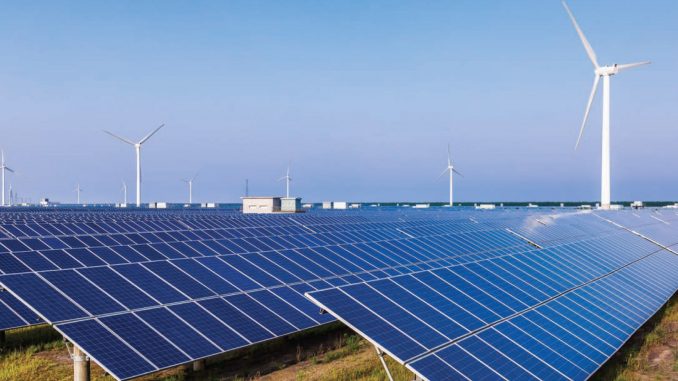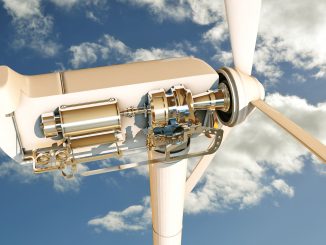
In line with the government’s aim to increase the share of green power in the country’s energy mix, a record 11.3 GW of renewable energy capacity was added in 2016-17. In comparison, the coal, gas, hydro and nuclear power segments added 10.6 GW, 926 MW, 1.6 GW and 1 GW of capacity respectively. This is the first time in the history of the Indian power sector that renewables have surpassed conventional sources of energy in terms of capacity addition.
Another first for the renewable energy sector is that solar capacity additions surpassed those of wind. During 2016-17, solar energy expanded by a record 5,525.98 MW while wind power increased by 5,502 MW, also a record in itself. Under the Paris Climate Agreement, the government committed to install 175 GW of renewable energy by 2022, of which 100 GW will be from solar and 60 GW from wind. India also promised to generate 40 per cent of its power from renewable energy sources by 2030. Of the country’s total installed capacity of 315.4 GW as of March 2017, 57 GW comprises renewable energy.
New wind regime
In 2016-17, the wind energy segment witnessed a record installation of 5,502.38 MW, registering a 60 per cent growth over the 3,400 MW of capacity added in 2015-16. With this, the total installed wind capacity increased from 27 GW to over 32 GW.
The record capacity addition can be attributed to a combination of factors. First, this was the last year that accelerated depreciation benefits were being offered at the rate of 80 per cent. From April 2017 onwards, these benefits have been reduced to 40 per cent. Second, there was uncertainty regarding the continuation of generation-based incentives. Third, the central and state governments have been playing a key role in promoting renewable energy, leading to increased investor interest.
But the biggest development in the segment was the introduction of competitive bidding for project allocation. The reverse auction-based 1 GW tender for wind projects issued by the Solar Energy Corporation of India (SECI) drew significant interest from the industry, with the lowest bids reaching Rs 3.46 per kWh, making the segment extremely competitive with other sources of power. SECI has recently released another tender for 1 GW of capacity. Several state governments have also announced their intent to move from feed-in tariffs (FiTs) to competitive bidding for future project allocations. In fact, certain states such as Andhra Pradesh have cancelled past allocations based on FiTs.
Meanwhile, there is a growing focus on new areas of opportunity including offshore wind, repowering and solar-wind hybrids. The government has come out with the National Offshore Wind Energy Policy, which aims at harnessing wind energy along India’s 7,600 km coastline.
Solar short of target, but leading on many counts
The solar power segment is taking rapid strides with the tariff for solar power falling steeply year after year. In the latest round of auctions conducted for 750 MW of capacity for the Bhadla Solar Park in Rajasthan, the tariff has hit a new low of Rs 2.44 per kWh (Phase III) and Rs 2.62 per kWh (Phase IV).
The declining tariffs are the result of a number of factors – some pertaining to the increasing trend of solar park-led development, wherein the transmission risk, payment defaults and number of clearances required can be minimised; others stemming from favourable global photovoltaic market conditions and cheaper credit. Financiers’ perception of the sector has also improved.
Even as the utility-scale segment grows at a rapid pace, rooftop solar too is gaining traction. The industry is gearing up for a rooftop solar tender of 500 MW, released by SECI, and many more large-scale tenders announced by various state nodal agencies. Moreover, the Ministry of New and Renewable Energy (MNRE) has proposed financial support of up to Rs 3.75 million per MW for up to 1,350 MW of rooftop solar capacity, to be used largely towards the upgradation of the distribution network and IT infrastructure.
In terms of solar power capacity addition, in 2016-17, the addition was 43 per cent below the target of 12 GW (7 GW utility based and 5 GW rooftop based). A significant part of the underachievement was in rooftop solar additions with only about 500 MW of capacity being added during the year.
However, the segment has set records on several counts, including surpassing wind capacity additions for the first time. With the growth in 2016-17 nearly doubling over the previous year, the cumulative solar capacity currently stands at 12,288.83 MW compared to 6,762.85 MW as of March 2016. Exceeding 12 GW of solar capacity is no mean achievement, especially considering that the capacity stood at just 2.6 GW three years back.
Among the states, Andhra Pradesh added the maximum solar capacity in 2016-17 (1,294.26 MW), followed by Karnataka (882.38 MW) and Telangana (759.13 MW). With this year’s additions, Andhra Pradesh now leads in terms of cumulative solar capacity (1,867.23 MW), surpassing Rajasthan (1,812.93 MW), which had been the top contender for the past three years. However, Gujarat, which had been leading among other states in solar generation for many years, is now at the fourth position with 1,249.37 MW of capacity, while Telangana is at number three with 1,286.98 MW of capacity.
As in previous years, in 2016-17, many projects were commissioned just in time to beat the year-end deadline. Of the 5,526 MW added, only 2,803.77 MW had been commissioned until February 2017, but it was followed by a spurt in additions of more than 2,700 MW in March 2017. This was the case for wind power as well.
Other positive developments in the solar power space include the implementation of the solar cities programme, the canal-based solar PV project scheme, and the forecasting and scheduling norms; the issuance of new solar renewable purchase obligations (RPOs); the notification of lower solar renewable energy certificate prices; and the release of the solar-wind hybrid policy. The Green Energy Corridors project and the Ujwal Discom Assurance Yojana have also been instrumental in reducing the risk perception for the solar projects.
All these developments augur well for meeting the 100 GW by 2022 solar target.
Outlook
The achievements in 2016-17 are a result of the combined efforts of the government and the industry. There has been an improvement in the compliance levels of states’ RPOs. Besides, there has been growing interest in buying renewable energy with tariffs touching record lows. In two separate tariff-based reverse auctions held in 2017, wind energy tariffs touched a historic low of Rs 3.46 per kWh while solar tariffs hit Rs 2.44 per kWh. Currently, 14 GW of capacity is reportedly under construction or at the design stage. A large portion of this capacity is expected to be commissioned during 2017-18. An additional 6 GW of solar capacity and an equivalent amount of wind capacity is also scheduled to be auctioned soon. The stage is clearly set for much higher growth in 2017-18.




